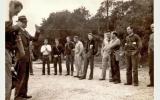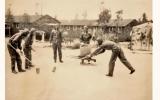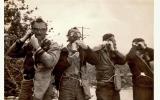CPS Unit Number 076-01
Camp: 76
Unit ID: 1
Operating agency: AFSC
Opened: 1 1943
Closed: 12 1946
Workers
Total number of workers who worked in this camp: 552
-
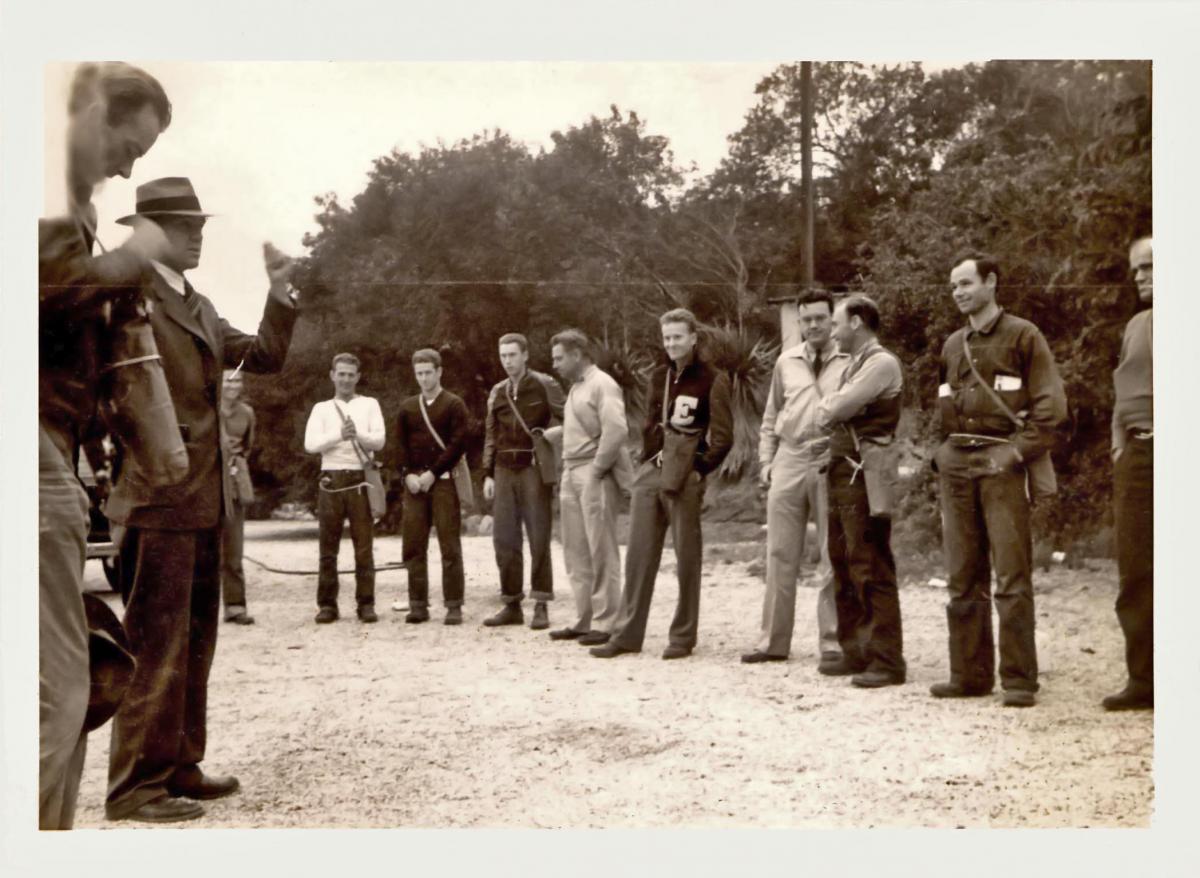 CPS Camp No. 76Glendora. Mobile Disaster Unit.
CPS Camp No. 76Glendora. Mobile Disaster Unit. -
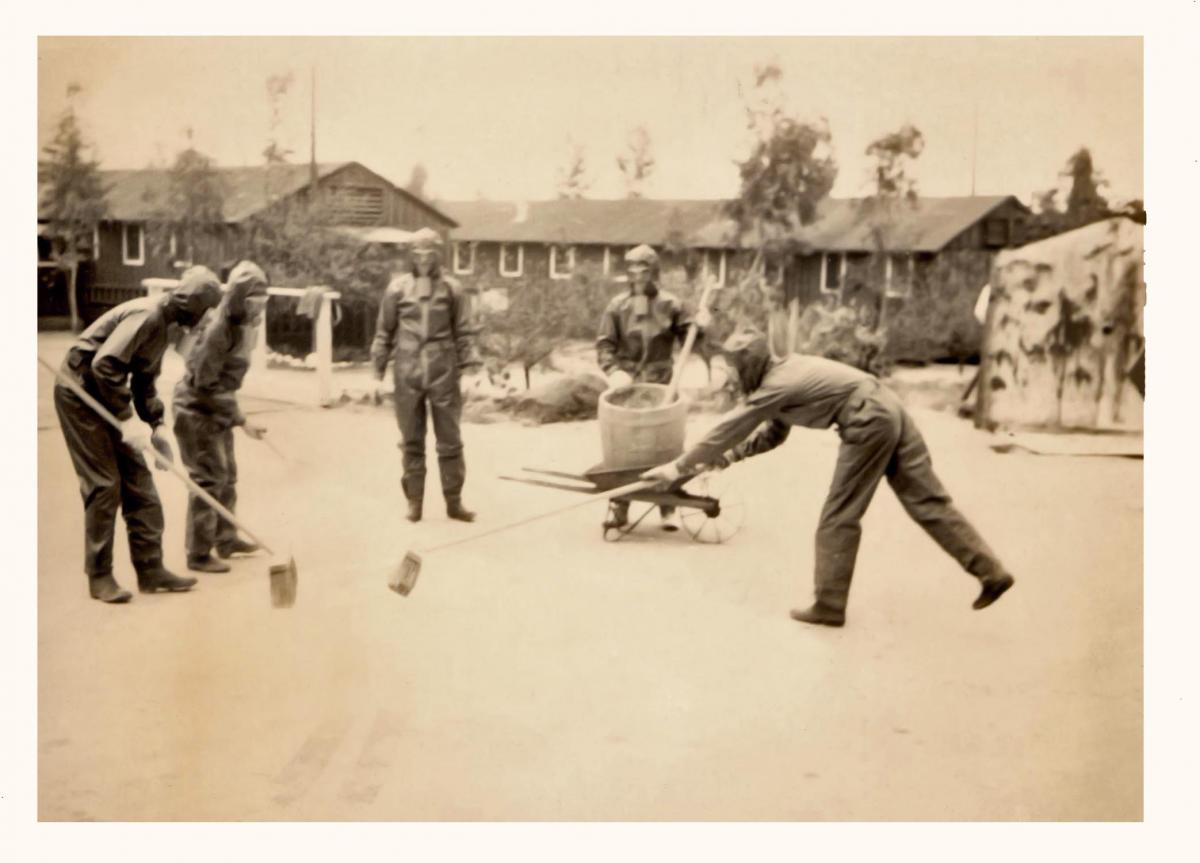 CPS Camp No. 765 CPS men sweeping and cleaning while wearing protective suits with face masks
CPS Camp No. 765 CPS men sweeping and cleaning while wearing protective suits with face masks -
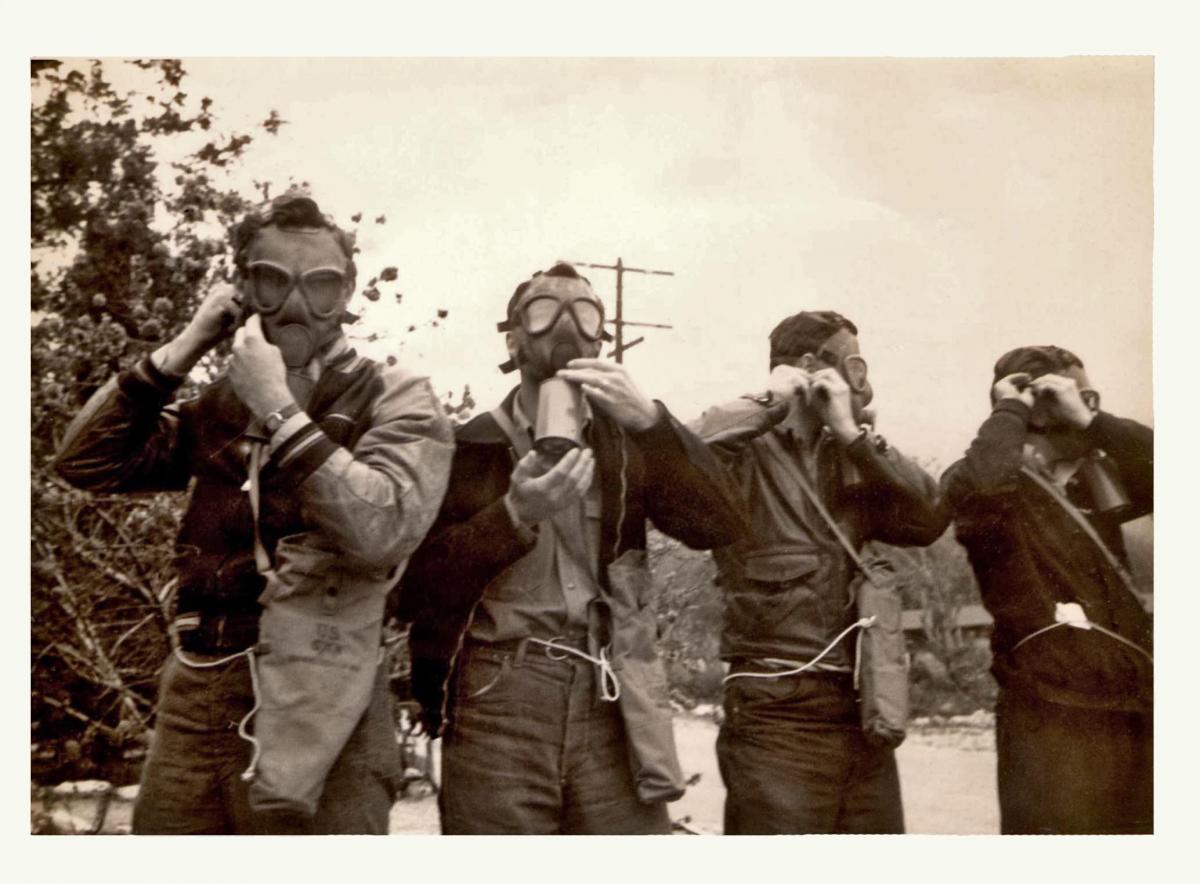 CPS Camp No. 76Putting on face masks (oxygen gear)
CPS Camp No. 76Putting on face masks (oxygen gear) -
 CPS Camp No. 76De Todo was a newsletter published by the men at Chilao which was a spike camp for Camp 76.Digital image from American Friends Service Committee: Civilian Public Service Records (DG 002), Swarthmore College Peace Collection, Swarthmore, Pennsylvania
CPS Camp No. 76De Todo was a newsletter published by the men at Chilao which was a spike camp for Camp 76.Digital image from American Friends Service Committee: Civilian Public Service Records (DG 002), Swarthmore College Peace Collection, Swarthmore, Pennsylvania
CPS Camp No. 76, a Forest Service camp located near Glendora, California opened in January 1943, continuing the work of CPS Camp No. 2, San Dimas Camp. American Friends Service Committee (AFSC) operated both camps until AFSC withdrew from CPS in March 1946. Selective Service operated the camp during its last months until it closed in December 1946. The men performed many kinds of work in multiple locations. They fought fires, conducted fire and soils studies, maintained recreational areas, planted trees, conducted a forest tree survey and filled a variety of staff roles.
The town of Glendora, twenty-three miles east of downtown Los Angeles, lies west of San Dimas which is twenty-eight miles northeast of downtown Los Angeles. The town of San Dimas, in the foothills of the San Gabriel Mountains, rests north of the Pacific Ocean. Both towns are in Los Angeles County.
At the end of 1943 the San Dimas CPS camp officially moved from the Tanbark Flat location in the Experimental Forest to the former Civilian Conservation Corps camp, which was south of the Big Dalton Canyon and three miles northeast of Glendora.
Since the camp required considerable improvements, unit men readied the living quarters and grounds prior to the relocation. The CCC camp location made educational and recreational facilities in the local area more readily available to unit members. (San Dimas Rattler, IV:9 [March 3, 1943] p. 1)
Directors: Arthur Marshburn*, Edwin Newman*, Clarence Yarrow, Bernard Waring
Nurse: Martha Rupel*, who also served as camp nurse at San Dimas.
*Also served as directors and nurse at CPS Camp No. 2 San Dimas open June 1941 through December 1942
As tended to be the case in the AFSC camps, the men reported diverse religious affiliation when entering CPS. As of June 1943, of the two hundred and sixteen men in the camp, forty reported Friends affiliation, thirty-six reported no religious affiliation, thirty-two claimed Methodist affiliation, fifteen Presbyterian; eight each reported Mennonite, Congregational or Jehovah’s Witness religious affiliation; seven each Molokan, Brethren or Baptist membership; four each reported Episcopal, Theosophist, Catholic, Church of Christ or Christadelphian membership; and the remaining men reported affiliation with twenty-one additional religious denominations.
Similarly, the COs had completed varying levels of education. While five men had completed less than eight grades of education, an additional twelve had completed all eight elementary grades. Sixty men reported high school as their highest level of education, with forty-five of those completing the twelfth grade. Of ninety-nine men who reported college education, thirty-eight had graduated. Eighteen men had completed one year of post graduate work, seventeen men had completed two years, and five men had completed three years of graduate work. In sum, nearly two-thirds of the men had completed some higher education or post graduate education.
According to the San Dimas Rattler of June 2, 1943, an issue reporting on Two Year Growth, COs worked at a number of sites.
Fifty-one assignees staffed the Dalton crew at the main camp. Some tabulated and analyzed data, performed drafting, secretarial and maintenance duties, while others maintained the kitchen and performed assistant director duties.
At Tanbark Flat, the Experimental Forest Field Headquarters, botanists and geologists along with others conducted fire and soils studies that involved data collection and analysis. Forty-six unit members performed this work.
At Chilao Spike, located sixty miles from Dalton, thirty-eight unit members performed recreational area maintenance and planted trees.
Tanker Crews, with six members each in fire season, worked from eight different locations--San Dimas, Camp Baldy, Rincon, San Antonio, Red Box, Angeles Crest, Tanbark, Dalton--standing by with a fire engine and performing maintenance work while awaiting action.
Fifteen men worked at Arcadia in the Angeles National Forest warehouse.
Two members, Paul Ledieff and Elmer Bredenstein staffed the Camp Farm. The tract of land, located sixteen miles from the base camp, came with water, seed and fertilizer. In return the camp supplied the labor and paid twenty-five cents per crate for the vegetables taken off the land for camp consumption.
At Devil Canyon, six men worked in a nursery for cork oaks, planting from acorns, maintaining the seedlings and planting as ready. In addition, other native plants grew in the nursery.
The Timber Cruise group of ten conducted a forest tree survey in San Bernardino National Forest.
The men continued to publish the San Dimas Rattler, which had begun in CPS Camp No. 2, at San Dimas.
In the February 17, 1942 issue of the San Dimas Rattler, one of the wives spoke out about CPS treatment.
I am not a “CPS wife”, I am just a girl married to a man in Civilian Public Service, that’s the point. . . . Wives have been made to feel a hindrance to the program, rather than partners in it. . . .I suggest that Friends CPS administrators rethink the “wife problem” and within limits of a liberal interpretation of S.S. rulings, help wives to share with their husbands the present government requirements for husbands. I speak only for one wife; perhaps others will have different ideas to express in the next Rattler. – A Wife (p. 3)
The recreation program at Dalton included an intra-camp basketball league, fencing, daily calisthenics and exercise, and football. Giles Liegerot supervised the Scott Methodist boys clubs while also serving as assistant director of the YMCA basketball leagues, both in Pasadena. Joe Gorman directed a boys club in Garvey Acres.
Those at Chilao Spike camp located about twenty-five miles from La Cañada, California, maintained an active Latin American Study Group, and published the newsletter De Todo, Latin American Unit, Glendora, California. The camp existed as a spike camp for both CPS Camp No. 2 at San Dimas and CPS No. 76. Unit members operated several co-op ventures—a store, a Credit Co-op, and a Transportation Trust for weekend trips to Pasadena.
The men at Chilao published Just Among Ourselves beginning in late 1942 continuing through the spring of 1944. Issue 18, March 17, 1944, announced that the camp would be closed, primarily because the Forest Service had not been able to keep a crew together due to many transfers in and out. The editors planned to produce one more issue, since one of its purposes was to keep in touch with Chilao alumni.
Tragedy struck at Dry Lake on the morning of April 6, 1943. Earl Keppler and John Mills were attempting to light the stove for breakfast when it exploded, creating a hot fire. The camp men administered first aid, and when they could not reach Tanbark by telephone, drove them in the truck the fourteen miles over narrow mountain roads to Tanbark where Martha Rupel gave what relief she could before calling the ambulance to take them to St. Luke’s Hospital in Pasadena. Keppler suffered burns over ninety to ninety-five percent of his body and died two days later. Mills, who had gone back to help Keppler escape through the window, although less severely burned, died eighteen days later of complications. Earl, an artist whose parents lived in Denver, had arrived at camp only three weeks earlier on parole after a year’s imprisonment for refusal to report for induction into the army. John, from Wichita, Kansas, known for his “ever-ready wit and humor”, had served at CPS Camp No. 23 at Coshocton, Ohio, before transferring in the previous August. (San Dimas Rattler, April 21, 1943, pp. 1, 3)
Paul Comly French, Executive Secretary of the National Service Board of Religious Objectors (NSBRO), addressed the Glendora men in an open letter, acknowledging not only the unpopularity of COs, but also the sense of isolation in all-male camps coupled with often tedious work and the “frustration from feeling that he never knows what quite all is happening or why”. The letter, in the Two Year Report edition of the San Dimas Rattler, recognized some had gone on record wanting pay, better use of manpower, accident insurance legislation, civil rights issues and more. He remarked that the most frequent complaints he received centered on leaves, furloughs, working hours and transfers. He asked for the men to weigh both “the assets and debits” of the CPS program, and to “fully separate matters of convenience from matters of conscience”. (Vol. IV:9, pp. 2, 4)
That same issue included reflections from Camp Director Oscar Marshburn, Camp Nurse Martha Rupel, campers E. A. Thomas, R. T. Bean, and H. B. Rickerman addressing assets and debits from each of their perspectives.
On June 30, 1943, Congress attached a rider to the Army appropriation bill prohibiting government financing for any CPS man engaged in college training or foreign service, both programs of high importance to CPS men. In the following month, Paul Furnas, Director of Friends CPS came to Glendora, reporting that NSBRO leaders intended to visit individual congressman in the fall to secure repeal of the Starnes Amendment. When asked if the churches should continue to support CPS, Furnas felt it should do so as an alternative to prison and to make possible “greater opportunity for domestic and foreign service”. (San Dimas Rattler, July 30, 1943, p. 5)
The September 18, 1943 issue reported on responses of men to Philadelphia on the question of Friends continuing participation in CPS. The Chilao branch men had sent their opinion that the Friends should withdraw from CPS; the Dalton branch camp committee had been gathering opinions from the men; the Tanbark meeting to render an opinion had been canceled due to fire calls.
A group of men, referring to themselves as “Pacifica Associates of Glendora” started “an independent weekly pacifist publication”. Pacifica Views “will seek to stimulate serious thought concerning both the basic and particular problems of pacifists” . . . .in the hopes that it will grow into “an organ for the interchange of ideas on these and other subjects”. The first issue included a description of pacifist study in CPS, letters, and a bibliography of articles in recent publications. “The four-page printed issue provides a welcome relief from the mimeographing of so many current pacifist publications (including, regretfully, the Rattler”. (San Dimas Rattler, June 16, 1943, p. 1)
Pacifica Associates, in 1942, also published a 140-page mimeographed study entitled “Pacifica Studies on Conscientious Objection”. Henry Geiger, a member of Pacifica Associates, wrote and published a weekly philosophical periodical called Manas after the war. (For background information and all issues, see http://www.manasjournal.org/)
The June 16, 1943 issue of San Dimas Rattler reported on government camps under the direct control of Selective Service without participation of any religious body. Several men were expressing interest to transfer out of Glendora and into government run camps and units.
During 1944, COs at different camps and units banded together to form the CPS Union (CPSU). Its major interests were to improve pay, benefits, including those for dependents, working conditions and rights of CPS men. The first local opened at CPS camp No. 46 Big Flats, New York, and in June of 1944 men from eleven local units met in New York to elect a temporary organizing committee of three men.
The CPSU, dominated by men from Friends camps and units, grew to approximately five hundred men in sixty-four camps, according to Sibley and Jacob. (p. 270) When the Friends turned over administration of their units to Selective Service in early 1946, a number of the CPSU locals remained active in the union, Glendora being one of those. The union endorsed negotiation as the tactic of choice and regarded strikes as a last resort. Much of the union publicity focused on shortcomings in CPS, particularly work inefficiency.
The Irresponsible, February 4, 1946 carried in the masthead “Concentration Camp Number 76”. The lead article, “An Open Letter to Forest Service Officials” ran over the signature “The Irresponsibles”, and described the view of CPS work as slave labor. The writers reminded the camp administration of increasing resistance to the CPS system. The publication purpose statement included, “It is in the hope of presenting critical and creative thinking and of stimulating action that this paper is presented”. The statement went on to define why the men were “The Irresponsibles”.
To refuse to make atom bombs, to refuse to drop them on men, women and children, to refuse to fight in the armed forces, to refuse to hate the Germans and Japanese, to refuse to uphold a society that creates wars, to refuse to make CPS successful – there are the marks of irresponsibility. So in CPS #76 we shall deem it an honor to develop irresponsibility to a fine art.
The article “Resistance Now!” outlined five strategies
1. We can refuse to take responsibility for the project that is the job of the camp administrator and his aides. . . We can only take orders.
2. We can slow down and do as little work as possible; we can at least keep the project part of CPS from working smoothly. . . .
3. We can refuse to work. . . .
4. We can walk out of CPS. . .
5. We can practice sabotage. . . It is a two-edged sword and is deemed inadvisable at this time.
The Glendora men organized a mass strike against restrictions in Selective Service policies, precipitated by a notice of transfer of two men out of the camp. Twenty-five men went on strike on April 24, 1946 to protest the transfer to CPS Camp No. 148 Minersville, California, portrayed as a “punishment camp”. Three weeks later the numbers had grown to eighty-two men on strike with sympathy strikes by men at other camps, including those at Wyeth in Oregon. The strike committee at Cascade Locks sent a letter to raise funds in support of the strike at Glendora. (Kovac p. 148)
On May 15, 1946 six were arrested at Glendora, two for refusing to transfer to the Minersville camp when ordered by Selective Service to do so, and four accused of refusal to carry out assigned duties. Placed in the county jail, they were supported by “a picket line of thirty strikers, wives and children of the men and ministers of the gospel” who kept a constant vigil until they were released on bail pending trial. (Sibley and Jacob p. 337)
The men at Glendora published a regular account of the action against their members in Strike News, a one-page sheet issued with a date and the numbered day of the strike. The May 16, 1946 issue, labeled “24th day of strike”, reported the arrest of John Atherton and Edward Behre who had refused orders to transfer to the government camp at Minersville, and Richard Stanhouse, Marvin Shapiro, Howard Golestein and Harold Holden, who were accused of allegedly being ringleaders and held on a charge of “willful refusal to obey orders of the Selective Service Director”. The final paragraph asked that telegrams be sent to congressmen asking for an investigation into the arrests, and to Attorney General Tom Clark as well.
Originally scheduled for a June date, the trial was postponed as a total of forty-seven men had been arrested and were awaiting trial by then. The government faced a mass refusal to work at Glendora. With many postponements of the trial, a Glendora Strikers’ Defense Committee formed, all of which attracted national attention. The men at Glendora, though refusing to work, continued to package food for European relief. Some men, while awaiting their trial, worked at a Los Angeles hospital assisting polio patients. A December 1946 Gallup poll revealed that sixty-nine percent of Americans favored releasing the COs in custody.
The case dragged out for nearly a year before resolution on March 24, 1947, one week before the expiration of the Selective Service Act. Charges were dropped against thirty-six of the remaining fifty-eight men. At the trial the two men considered ringleaders (John Atherton and Edward Behre) were sentenced to two years and immediately placed on probation with their parents as custodians. A few days later the remaining twenty men were sentenced to ten months for failure to work. “All sentences were suspended and two years’ probation was decreed”. (Sibley and Jacob p. 339)
During the remainder of 1947, many peace associations, churches and civil liberties organizations demanded amnesty for the remaining three hundred imprisoned American COs. Prominent Americans, including Pearl S. Buck, Harold L. Ikes, Reinhold Niebuhr and Walter Reuther, joined the campaign to restore civil rights to COs in prison and on parole. On Christmas Eve, 1947, President Truman signed a “selective amnesty” proclamation, pardoning most objectors who had violated the law for religious reasons, but withholding pardon from those classified as political objectors. (Sibley and Jacob pp. 395-98)
De Todo, Latin American Unit, Glendora, California, Vol. 1:1, July, 1944 Journal of Unitology Vol. 1 (June 16, 1944) in the Swarthmore College Peace Collection, American Friends Service Committee: Civilian Public Service Records (DG002), Section 3, Box 15.
For more information on women COs see Rachel Waltner Goossen, Women Against the Good War: Conscientious Objection and Gender on the American Home Front, 1941-47. Chapel Hill, NC: The University of North Carolina Press, 1997.
For stories from men who, as COs, walked to a different drummer during World War II, see Mary R. Hopkins, Editor, Men of Peace: World War II Conscientious Objectors. Caye Caulker, Belize: Producciones de le Hamaca, 2010, D. Thurston Griggs pp. 203-211.
Just Among Ourselves, Spike of CPS 76 Issue 14 (May 13, 1943); Issue 18 (March 17, 1944) in the Swarthmore College Peace Collection, American Friends Service Committee: Civilian Public Service Records (DG002), Section 3, Box 15.
See also Jeffrey Kovac, Refusing War Affirming Peace: A History of Civilian Public Service Camp No. 21 at Cascade Locks. Corvallis, OR: Oregon State University Press, 2009.
San Dimas Rattler Vol. IV No. 9 (February 3, 1944); Vol. IV No. 10 (February 17, 1943); Vol. IV No. 14 (April 21, 1943); Vol. V No. 1 June 2, 1943); Vol. V. No. 2 (June 16, 1943); Vol. V No. 3 (June 30, 1943); Vol. V No. 4 (July 16, 1943); Vol. V No. July 30, 1943); Vol. V No. 8 (August 18, 1943); Vol. 5 No. 10 (October 27, 1943) in the Swarthmore College Peace Collection, American Friends Service Committee: Civilian Public Service Records (DG002), Section 3, Box 15.
For an in depth history of conscientious objection in the United States, see Mulford Q. Sibley and Philip E. Jacob, Conscription of Conscience: The American State and the Conscientious Objector, 1940-1947. Ithaca, NY: Cornell University Press, 1952.
Strike News, (May 18, 1946); May 29, 1946); June 17, 1946); March 22, 1947) in the Swarthmore College Peace Collection, American Friends Service Committee: Civilian Public Service Records (DG002), Section 3, Box 15.
See Steven, J. Taylor, Acts of Conscience: World War II, Mental Institutions, and Religious Objectors. Syracuse, NY: Syracuse University Press, 2009.Taylor
The Irresponsible, No. 1 (February 4, 1946) in the Swarthmore College Peace Collection, American Friends Service Committee: Civilian Public Service Records (DG002), Section 3, Box 15.
Wikipedia Encyclopedia entries for San Dimas, California and Glendora, California, accessed September 1, 2010.
